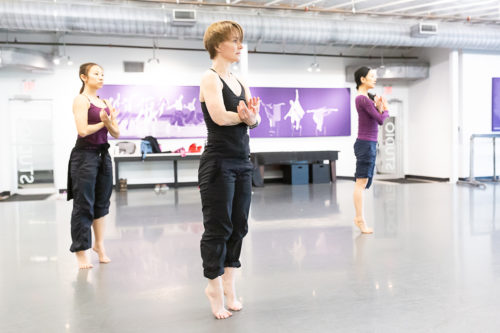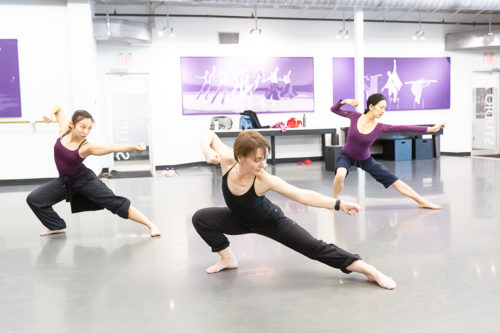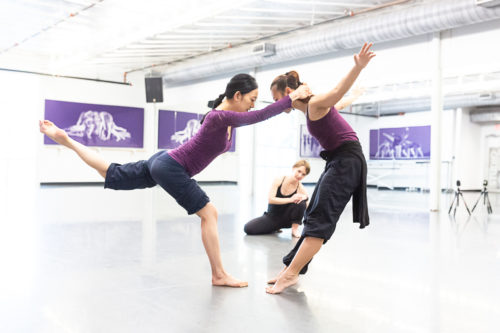The Mysterious Consideration of Transitory Sound and Movement Collective

All photos by Lynn Lane
The artists of Transitory Sound and Movement Collective refer to themselves as a “living sculpture” rather than a dance company or a sound ensemble. Their work is an ongoing conversation between sound, led by Founding Artistic Director Lynn Lane, and movement, shaped by Founding Member Jennifer Mabus. Witnessing audiences are welcomed into their upcoming creation, presented by the Asia Society Texas Center, called Moving Mountains through Clouds on March 22, 2019.
For this quiet, meditative piece, Lane drew inspiration from the Asia Society Texas Center (ASTC) building which was designed by renowned Japanese architect Yoshio Taniguchi. He explains, “I thought a lot about the architecture of the building and the fog rolling off as you look out the upstairs window. I thought of the building as a mountain moving through the clouds of Houston. The mountain became symbolic of our struggles in life. The mist was trying to move the things that are immovable, and as the clouds move across the mountains, it feels as though we are moving the mountains. But sometimes our struggles are still there.”
Struggle also plays a role in the movement. “We want to take the Asian forms practiced in the building and use them as inspiration,” explains Mabus. “We started the movement by playing with lines from tai chi and it grew into a play between tension and release. We found how the dynamic could be a conversation between two dancers.” The two other dancers in this performance are Nao Kusuzaki, a Soloist with Houston Ballet, and Evelyn Toh who is a graduate student at Sam Houston State University. “It has been a very collaborative and creative process to bring together three different experiences,” says Mabus, who has an impressive performance resume of dance making, international performing, and now Chairs the Dance Program at the University of St. Thomas.
 Prior to this season, TSMC works have had a call and response relationship between the sonic and the kinetic, but this year, they have invited more rigor into their work. Mabus is now beginning with more set structure than she has in the past, but the collaborative creation process remains the same. The rehearsal process holds onto the dedication they have for all artistic voices having value, and taking turns leading and supporting. That way, the parts evolve together. Lane states, “There is a three-dimensionality about the work. You will see some lines blur. We are really meeting in the middle and bringing what we have to the experience.”
Prior to this season, TSMC works have had a call and response relationship between the sonic and the kinetic, but this year, they have invited more rigor into their work. Mabus is now beginning with more set structure than she has in the past, but the collaborative creation process remains the same. The rehearsal process holds onto the dedication they have for all artistic voices having value, and taking turns leading and supporting. That way, the parts evolve together. Lane states, “There is a three-dimensionality about the work. You will see some lines blur. We are really meeting in the middle and bringing what we have to the experience.”
Lane formats TSMC performances like a Quaker practice. There is not a crafted beginning–the performance is already happening before start time. Lane says, “We never walk onto the stage and say ‘we are ready to begin now.’ The piece began months ago. They will enter into something that has already begun. The audience will settle into the figurative and literal silence and begin to experience our conversation and what we’ve decided to share in that moment.”
The idea of dialogue struck Stephanie Todd Wong, Director of Performing Arts & Culture at ASTC. “Our mission is educational in nature, creating cross-cultural dialogue and giving people the chance to see things from a new perspective. We want to build empathy.” TSMC’s improvisation work is a conversation, and audiences are witnessing the very dialogue that ASTC seeks in its mission. ASTC has presented an impressive catalog of international and national artists. Moving Mountains through Clouds is an opportunity to watch local artists in the building. Most often it is visual art that is created in response to the ASTC building. “I found it interesting to see how TSMC was performing conversations inside of specific spaces. Creating a performance in response to a building was interesting to me,” says Wong.
 The sound artists include TSMC Core Members Ingrid Gerling and Lane as well as collaborators Carson Marshall and Thomas Frey. Instrumentation includes handmade lo-fi and highly crafted traditional instruments. They include Kalimba, Kaiser Boxes, Crystal Bowls, Violin, Clarinet and Percussion. Lane says “From the very beginning of TSMC, we’ve always been focused on consideration. We are consciously paying homage to the culture represented in the building.” The collective does not play only improvised music; there is a blend of structure and freedom. The relationship between music and movement often gives sound the role of a guide. Lane describes, “we think of the music as the conductor setting the space and pace and the overall feel of the piece.”
The sound artists include TSMC Core Members Ingrid Gerling and Lane as well as collaborators Carson Marshall and Thomas Frey. Instrumentation includes handmade lo-fi and highly crafted traditional instruments. They include Kalimba, Kaiser Boxes, Crystal Bowls, Violin, Clarinet and Percussion. Lane says “From the very beginning of TSMC, we’ve always been focused on consideration. We are consciously paying homage to the culture represented in the building.” The collective does not play only improvised music; there is a blend of structure and freedom. The relationship between music and movement often gives sound the role of a guide. Lane describes, “we think of the music as the conductor setting the space and pace and the overall feel of the piece.”
Audiences can expect a meditative, quiet piece. Lane says, “This will penetrate the space in a subtle way. This is probably the most considered piece we’ve done. We are shaping the space differently than we have before. This piece is site-specific but we are truly changing and shifting the perception of the space. It isn’t just movement and sound, there are other things that are coming into the piece that help create the world that I can’t talk about. Our goal is to create something so captivating that at the end we are able to enter into the silence of the community and reflect on the experience that we’ve shared with them.”
Be a part of the dialogue on March 22, 2019 at 8pm. Also on display at ASTC is the Super Sarap exhibition where artists artists Mik Gaspay, Jeanne F. Jalandoni, Charlene Tan, and O.M. France Viana revisit commonplace objects and food within Filipino cooking through sculpture, photography, and video.



Recent Comments